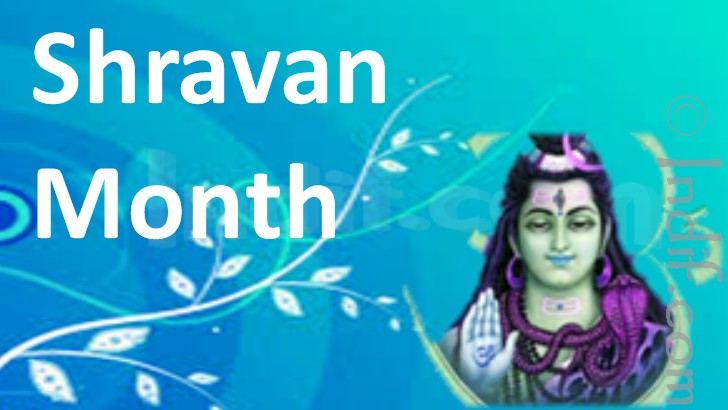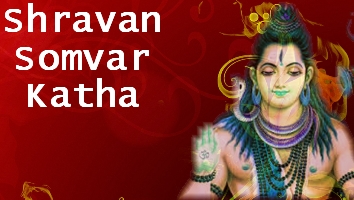![]()
The month of Shravan, popularly known as Sawan mas, is the fifth month of the Hindu calender. Shravan is considered the holiest month of the year. It is the first and most auspicious month of Chatur Mas, the four holiest months in the Hindu Calendar. Almost all the days of Shravan month are considered auspicious. The month of Shravan derives its name from the star “Shravan” that rules the sky on Poornima.
The Shravan Month signs the blessings of Lord Shiva and Lord Vishnu. This month is beneficial for those who believe in the glory of Lord Shiva. It is believed that worshiping Lord Shiva during Shravan month is considered more powerful than worshiping during normal days. Each day of Shravan is regarded as very pious and special prayers and rituals are performed at Lord Shiva Temples. Each Monday of this month, known as Shravan Somvar, is a special day in Shiva temples where the dharanatra hangs over the linga or the idol to bathe it with holy water, day and night. Devotees pile the linga high with Bel leaves and flowers and fast till sunset. Apart from Monday women keep fasts on Tuesdays and Fridays of the month too. On Tuesdays newly married brides keep the Mangla Gauri Vrat to get rid of bad omens and married women keep Varalaksmi Vrata on Friday. Wednesday is dedicated to Vittala, a form of Lord Vishnu. While on Thursday, devotees worship Buddh and Guru. Saturday is dedicated to Saturn (Shani). It is also known as Shravan Saturdays, with the object of obtaining wealth and blessings. On Sundays worshiping ‘Surya’ (Sun God) and is especially important during Shravan month.
Some other auspicious occasions in the month of Shravan are Hariyali Amavasi, Hariyali Teej, Nag Panchami, Tulsi Das Jayanti,Putradaikadashi, Shravan Purnima, Rishi Panchami,and Raksha Bandhan..
The Story of Shravan Month:
According to the legend the churning of the oceans "Samudra Mantham" took place in the month of Shravan, fourteen different types of Rubies came out. Which included -
- Lakshmi: Goddess of Fortune and Wealth or Vishnu’s consort;
- Kaustabha: The most valuable gem in the world;
- Parijat: Divine Flowering Tree with blossoms that never fade;
- Varuni: Goddess and creator of alcohol;
- Dhanvantari: The Doctor;
- Chandra: Moon;
- Kamadhenu: A Wish-fullfiling Holy Cow;
- Kalpavriksha: A Wish-fullfiling Tree;
- Airavata: Elephant of Lord Indra;
- Uchhaishravas: A Celestial seven-headed horse;
- Sranga: Bow of Vishnu;
- Shanka: Lord Vishnu’s conch;
- Amrit: Nectar of immortality; and
- Halahal: Pot of poison.
Thirteen of these rubies were distributed amongst the demons, except for Halahal (poison). Lord Shiva drank the Halahal and stored it in his throat, hence the name Neelakanta (blue throat) is attributed to Lord Shiva. To reduce the strong effect of the poison, Lord Shiva wore the crescent moon on his head. All the Gods thereafter started offering the Ganges water for Lord Shiva to reduce the effect of the poison.
Since then, devotees offer the Ganga Jal (Ganges water) to Shiva, in the month of Shravan.
How to perform Shiv Puja in Shravan month:
For Shiva devotees, the Shravan month is a month of fasting, worshipping, praying and performing Abhishek to gain peace, health, happiness as well as awareness of one’s self. Some Shiva devotees observe strict fast for the entire month of Shravan, while others observe fasting on Mondays.
During the month of Shravan, devotees of Lord Shiva perform the ritual of Abhishek with 11 different worship materials - Milk, Curd, Ghee, Honey, Sugar, Grass, Coconut Water,Grains of Water, Jagggery Water, Barley Water, and Ganga Jal. Each of the ingedients carry a meaning to it. Like Milk represents happiness for Children; Curd(Yogurt) for peace of mind; Ghee stands for liberation from sin's; Honey signifies money; Sugar is for achievements; Grass represents health; Coconut Water is for ancestry growth; Grains of Water symbolizes prosperity; Jagggery Water for academic's; Barley Water is a solution to the torment; and Ganga Jal for attaining moksha.
It is also believed that Lord Shiva fulfills the wishes of his devotees, if worshipped with Bel leaves. According to legends, Lord Shiva resides in the roots of Bel Patra tree. A person who gives water or Ganga Jal to the tree of Bel, achieves the virtues of visiting all pilgrimages.
Regional Observance of Shravan Month:
There is fifteen days difference in starting time of Shravan month depending on the respective lunar calendar of the region. The northern states of India follow Poornimant calendar (the month begins with the Poornima or the full moon), while sourthern States follow Amavasyant calendar (the month begins from Amavasya or the New Moon).
In Maharashtra, Gujarat, and South - Indian states, Amavasyant Lunar Calendar is followed while in North Indian states Poornimant Calendar is followed. Hence, Shravan month starts fifteen days before in Northern India, then in Southern part of India.









